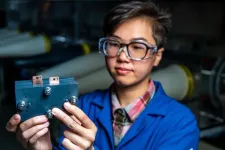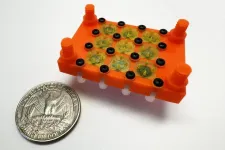(Press-News.org) We hope to be cured when we stay in hospital. But too often, we acquire new infections there. Such ‘healthcare-associated infections’ (HAI) are a growing problem worldwide, taking up an estimated 6% of global hospital budgets. In the EU alone, HAIs add up to more than 3.5 million cases per year, resulting in 2.5 million disability-adjusted life years, a cost of up to €24 billion, and 90,000 deaths. They are likewise the sixth leading cause of death in the US.
Patients with lowered immune defenses, and in some hospitals, poor adherence to hygiene protocols, allow HAIs to thrive. Furthermore, antibiotics are widely used in hospitals, which tends to select for hardy, resistant strains of bacteria. When such resistance genes lie on mobile genetic elements, they can even jump between bacterial species, potentially leading to novel diseases.
“Here we show that hospital sink drains host bacterial populations that change over time, despite impeccable cleaning protocols in the particular hospital we looked at,” said Dr Margarita Gomila, a professor at the University of the Balearic Islands in Spain, and the senior author of a study in Frontiers in Microbiology.
“These results highlight that controlling bacterial growth in drains, and preventing colonization by new strains of such hard-to-disinfect niches, is likely a global problem.”
Rigorous cleaning protocols
Gomila and her coworkers focused on sink drains in a single modern university hospital on the island of Majorca, built in 2001 and managed by the health service of the Balearic Islands. Cleaning protocols there are state-of-the-art: sinks and their drains are routinely cleaned with bleach, as well as disinfected with chemicals and pressurized steam every fortnight, or every month in non-patient areas. Once a year, drainpipes are hyperchlorinated at low temperature.
Four times between February 2022 and February 2023, they used cotton swabs to sample six drains in each of five wards: two for intensive care, including a brand-new one; one ward each for hematology, short stays, and general medicine; as well as a microbiology laboratory. They cultured the sampled bacteria on five different media and at two different temperatures, and identified the resulting 1,058 isolates with DNA barcoding and mass spectrometry. They then used an automated platform to test whether each of 219 isolates were resistant to a range of antibiotics.
The authors identified a total of 67 different species from the drains. The diversity in most drains went up and down over time with no clear pattern – seasonal or otherwise. The greatest diversity occurred in general medicine and intensive care, while the fewest isolates were found in the microbiology laboratory. Strikingly, the new intensive care unit, opened in July 2022, already showed a high level of bacterial diversity from the opening, on a par with its longer-established twin.
Dominant across wards were six Stenotrophomonas species as well as Pseudomonas aeruginosa, a pathogen known to cause ventilator-associated pneumonia and sepsis, and characterized by the WHO as one of the greatest threats to humans in terms of antibiotic resistance. At least 16 other Pseudomonas species were also found at various times and in various wards, but especially in the short-stay ward.
Other notorious hospital-associated pathogens found repeatedly were Klebsiella pneumoniae in the general medicine ward, Acinetobacter johnsonii and Acinetobacter ursingii in general medicine and intensive care, Enterobacter mori and Enterobacter quasiroggenkampii in the short-stay ward, and Staphylococcus aureus in intensive care and hematology.
“The bacteria we found may originate from many sources, from patients, medical personnel, and even the environment surrounding the hospital. Once established in sink drains, they can spread outwards, posing significant risks to immunocompromised patients above all,” said Gomila.
Antibiotic resistance
Of the species found here, Klebsiella, Enterobacter, and P. aeruginosa feature among the so-called ESKAPE group of bacteria, known to thrive in hospital settings and to show frequent multi-resistance and a high potential for causing illness.
In the present study, 21% of P. aeruginosa isolates were found to be resistant to at least one class of antibiotics. Multiple Klebsiella and Enterobacter strains detected proved resistant to the third-generation antibiotic cephalosporin, but not to the carbapenems commonly used today against multidrug-resistant infections.
Worryingly, the blaVIM gene, which makes its carriers resistant even to carbapenems, was detected sporadically in a minority of P. aeruginosa strains from the two intensive care wards, the general medicine ward, and the short-stay ward.
The authors concluded that hospital drains can serve as reservoirs for both known and emerging pathogens, some of which exhibit strong antibiotic resistance.
“Cleaning protocols are important and should be frequently applied, especially in wards that are kept separate precisely to slow the spread of potentially harmful bacteria. But to get to the bottom of the problem, it’s essential to study the source of these bacteria and their routes of transmission,” reminded first author José Laço, a PhD student in Gomila’s laboratory.
END
Dangerous bacteria lurk in hospital sink drains, despite rigorous cleaning
Even in modern hospitals, drains can serve as reservoirs for known and novel pathogens, shows study
2025-02-14
ELSE PRESS RELEASES FROM THIS DATE:
Mini flow battery speeds energy storage research
2025-02-14
RICHLAND, Wash.—Sometimes, in order to go big, you first have to go small. That’s what researchers at the Department of Energy’s Pacific Northwest National Laboratory have done with their latest innovation in energy storage.
With a goal to speed the time to discovery of new grid energy storage technology, the team designed a compact, high-efficiency flow battery test system that requires an order of magnitude less starting material while delivering results equal to the standard lab-scale ...
Graphite production gets a makeover
2025-02-14
Collaboration efforts between the Texas A&M University Artie McFerrin Department of Chemical Engineering and the U.S. Department of Energy Advanced Research Projects Agency-Energy (ARPA-E) have led to innovative research on how petroleum coke is processed.
This almost $3 million three-year research project will convert petroleum coke to graphite for energy storage. The newer process uses a lower temperature and shorter time to produce graphite from petroleum coke.
This new catalytic graphitization technology will ...
Ancient Egyptian mummified bodies smell ‘woody,’ ‘spicy’ and ‘sweet’
2025-02-14
UCL Press Release
Under embargo until Friday 14 February 2025, 00:01 UK time / 19:01 Thursday 13 February US Eastern time
Ancient Egyptian mummified bodies smell ‘woody,’ ‘spicy’ and ‘sweet’, finds a new study led by researchers from UCL and the University of Ljubljana, revealing new details about mumification practices.
The research, published in Journal of the American Chemical Society, is the first time that the smells of mummified bodies have been systematically studied combining a mix of instrumental and sensory techniques, including an electronic ‘nose’ ...
MIT engineers develop a fully 3D-printed electrospray engine
2025-02-13
CAMBRIDGE, MA – An electrospray engine applies an electric field to a conductive liquid, generating a high-speed jet of tiny droplets that can propel a spacecraft. These miniature engines are ideal for small satellites called CubeSats that are often used in academic research.
Since electrospray engines utilize propellant more efficiently than the powerful, chemical rockets used on the launchpad, they are better suited for precise, in-orbit maneuvers. The thrust generated by an electrospray emitter is tiny, so electrospray engines typically use an array of emitters that are uniformly ...
Speculum exams unnecessary for HPV screening
2025-02-13
Genital human papillomavirus is the most common sexually transmitted infection in the United States and is thought to be responsible for more than 99% of cervical cancers.
HPV screening usually entails a speculum-based exam, which is an uncomfortable experience for most patients, especially those who have physical disabilities.
In two studies, published in Preventive Medicine Reports and JAMA Network Open, University of Michigan researchers are the first to demonstrate in the U.S. that self-sampling is just as effective as speculum-based testing for HPV detection.
Most people who have HPV are usually unaware that they have it.
By ...
Reduced prediabetes in people who ate broccoli compound
2025-02-13
The chemical compound sulforaphane found in broccoli sprouts can be linked to improved blood sugar levels in prediabetes, a precursor to type 2 diabetes. This has been shown in a study conducted at the University of Gothenburg. The broccoli compound had a more significant effect on blood sugar levels in certain people.
Researchers at the University of Gothenburg have previously identified sulforaphane as an antidiabetic agent in type 2 diabetes. A patient study conducted in 2017 demonstrated significantly lower blood sugar in people with diabetes after they took large ...
Landmark atlas reveals how aging breast tissue shapes breast cancer risk
2025-02-13
Aging is a privilege, but it also brings risks—including an increased likelihood of developing age-related diseases including cancer. Researchers at The Jackson Laboratory (JAX) have created a landmark atlas of how healthy breast tissue ages, revealing key cellular, molecular, and genetic changes that may tip the balance toward breast cancer development. Their findings, published recently in Nature Aging, provide a valuable open-access resource for the scientific community to explore aging and its role in increased cancer risk.
Rewriting ...
SHEA supports key federal advisory committees
2025-02-13
The Society for Healthcare Epidemiology of America (SHEA) urges incoming Secretary of the U.S. Department of Health and Human Services, Robert F. Kennedy Jr., to resume the federal advisory committees for key health-related priority issues as provided under the Federal Advisory Committees Act. Federal advisory committees are an important aspect of the deliberative process for reviewing important scientific information among federal agencies and members of the public as new evidence becomes available. The ability for members ...
Neurologic complications of flu nearly 50 times greater for children with underlying neurologic conditions
2025-02-13
Many clinicians do not consider neurologic complications of the flu when discussing vaccination or treatment of influenza with families.
A recent study that explored the neurologic impact of flu in children aims to change that.
“Serious Neurologic Events with Seasonal Influenza in Young Children,” published in Academic Pediatrics, the official journal of the Academic Pediatric Association, looked at the population-based incidence of underrecognized influenza-associated serious neurologic events in children less than 5 years of age.
While serious neurologic complications are uncommon in young children, the study showed a much higher incidence, ...
Killing H5N1 in waste milk — an alternative to pasteurization
2025-02-13
Pasteurization is the only widely recognized method of killing H5N1, the virus that causes bird flu, in milk. However, pasteurization can be expensive and fewer than 50% of large dairy farms pasteurize waste milk.
Waste milk includes colostrum, the first milk after calving; milk from cows treated with antibiotics or other drugs; or any other factor that can make milk unsuitable and unsellable for human consumption. On farms, raw waste milk poses a potential risk of spreading avian flu, which so far has been confirmed ...
LAST 30 PRESS RELEASES:
Making lighter work of calculating fluid and heat flow
Normalizing blood sugar can halve heart attack risk
Lowering blood sugar cuts heart attack risk in people with prediabetes
Study links genetic variants to risk of blinding eye disease in premature infants
Non-opioid ‘pain sponge’ therapy halts cartilage degeneration and relieves chronic pain
AI can pick up cultural values by mimicking how kids learn
China’s ecological redlines offer fast track to 30 x 30 global conservation goal
Invisible indoor threats: emerging household contaminants and their growing risks to human health
Adding antibody treatment to chemo boosts outcomes for children with rare cancer
Germline pathogenic variants among women without a history of breast cancer
Tanning beds triple melanoma risk, potentially causing broad DNA damage
Unique bond identified as key to viral infection speed
Indoor tanning makes youthful skin much older on a genetic level
Mouse model sheds new light on the causes and potential solutions to human GI problems linked to muscular dystrophy
The Journal of Nuclear Medicine ahead-of-print tip sheet: December 12, 2025
Smarter tools for peering into the microscopic world
Applications open for funding to conduct research in the Kinsey Institute archives
Global measure underestimates the severity of food insecurity
Child survivors of critical illness are missing out on timely follow up care
Risk-based vs annual breast cancer screening / the WISDOM randomized clinical trial
University of Toronto launches Electric Vehicle Innovation Ontario to accelerate advanced EV technologies and build Canada’s innovation advantage
Early relapse predicts poor outcomes in aggressive blood cancer
American College of Lifestyle Medicine applauds two CMS models aligned with lifestyle medicine practice and reimbursement
Clinical trial finds cannabis use not a barrier to quitting nicotine vaping
Supplemental nutrition assistance program policies and food insecurity
Switching immune cells to “night mode” could limit damage after a heart attack, study suggests
URI-based Global RIghts Project report spotlights continued troubling trends in worldwide inhumane treatment
Neutrophils are less aggressive at night, explaining why nighttime heart attacks cause less damage than daytime events
Menopausal hormone therapy may not pose breast cancer risk for women with BRCA mutations
Mobile health tool may improve quality of life for adolescent and young adult breast cancer survivors
[Press-News.org] Dangerous bacteria lurk in hospital sink drains, despite rigorous cleaningEven in modern hospitals, drains can serve as reservoirs for known and novel pathogens, shows study






